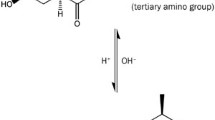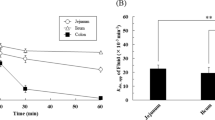Summary
After intraluminal injection of 0.5 ml buffer solution into closed jejunal segments (length, 3–5 cm) of anesthetized rats the appearance rates of a series of labeled substances in jejunal venous blood were measured for 30 min in situ (initial concentration, 0.02–10 mmol/1 or 1 GBq/1 tritiated water). The appearance rates quickly rose to a maximum and then declined almost exponentially. Model analysis of the descending of branch of the curves by two one-compartment models (perfect luminal mixing, radial diffusion without convection) revealed a relative pre-epithelial diffusion resistance of nearly 100% for benzoic acid, salicylic acid, l-lysine (0.02 and 1 mmol/1), α-methyl-d-glucoside, and l-phenylalanine; 80% to 95% for aniline and butanol; 50% to 80% for benzyl alcohol, theophylline, aminopyrine, antipyrine, dodecanol, and d-galactose; approximately 40% for tritiated water; approximately 30% for l-lysine (10 mmol/1); 10% to 20% for urea and benzylamine; and approximately 4% for erythritol. The shape of the curves was well described by a two-compartment model (intestinal lumen and “tissue”, radial luminal diffusion without convection); the variability of the data, however, prevented closer analysis of the parameters of this model. Since pre-epithelial diffusion (unstirred layer) in the closed jejunal segment without peristalsis is the rate limiting step in the absorption process of highly permeant substances, information on intestinal epithelium can be obtained only with poorly permeant substances.
Similar content being viewed by others
References
Anderson JS, Saddington K (1949) The use of radioactive isotopes in the study of the diffusion of ions in solution. J Chem Soc: S381–S386
Braybrooks MP, Barry BW, Abbs ET (1975) The effect of mucin on the bioavailability of tetracycline from the gastrointestinal tract; in vivo, in vitro correlations. J Pharm Pharmac 27: 508–515
Churchill RV (1972) Operational mathematics, 3rd edn. MacGraw-Hill, New York, pp 71, 240
Crank J (1964) The mathematics of diffusion. Clarendon, Oxford, pp 4, 62, 73
Dainty J, House CR (1966) “Unstirred layers” in frog skin. J Physiol 182:66–78
Daniel C, Wood FS (1971) Fitting equations to data. Wiley, New York
Elliott RL, Amidon GL, Lightfoot EN (1980) A convective mass transfer model for determining intestinal wall permeabilities: Laminar flow in circular tube. J Theor Biol 87:757–771
Fisher RB, Gardner MLG (1974) A kinetic approach to the study of absorption of solutes by isolated perfused small intestine. J Physiol 241:211–234
Gibaldi M, Perrier D (1982) Pharmacokinetics. 2nd edn. Marcel Dekker, New York Basel, p 45
Hartley HO (1961) The modified Gauss-Newton method for the fitting of non-linear regression functions by least squares. Technometrics 3:269–280
Holzheimer G, Winne D (1986) Influence of dietary fiber and intraluminal pressure on absorption and pre-epithelial diffusion resistance (unstirred layer) in rat jejunum in situ. NaunynSchmiedeberg's Arch Pharmacol 334:514–524
Lherminier M, Alvarado F (1981) Virtual elimination of the interferences of unstirred water layers on intestinal sugar transport kinetics by use of the tissue accumulation method at appropriate shaking rates. Pflügers Arch 389:155–158
Lucas M (1982) Restriction of hydrogen and sodium ion diffusion in porcine gastric mucin: a concentration dependent phenomenon. Adv Exp Med Biol 144:193–195
McQueen S, Hutton D, Allen A, Garner A (1983) Gastric and duodenal surface mucus gel thickness in rat: Effects of prostaglandins and damaging agents. Am J Physiol 245:G388-G393
Miyamoto Y, Hanano M, Iga T (1983) Concentration profile in the intestinal tract and drug absorption model: Two-dimensional laminar flow in a circular porous tube. J Theor Biol 102:585–601
Nimmerfall F, Rosenthaler J (1980) Significance of the goblet-cell mucin layer, the outermost luminal barrier to passage through the gut wall. Biochem Biophys Res Comm 94:960–966
Pfleger K (1975) Methods for the investigation of absorption in animals. In: Forth W, Rummel W (eds) Pharmacology of intestinal absorption: Gastrointestinal absorption of drugs, vol 2. Pergamon, Oxford, pp 797–817
Spector WS (1956) Handbook of biological data. Saunders, Philadelphia, p 51
Wang JH (1951) Self-diffusion and structure of liquid water. I. Measurement of self-diffusion of liquid water with deuterium as tracer. J Am Chem Soc 73:510–513
Winne D (1973) The influence of blood flow on the absorption of l- and d-phenylalanine from the jejunum of the rat. NaunynSchmiedeberg's Arch Pharmacol 277:113–138
Winne D (1977) The influence of unstirred layers on intestinal absorption. Excerpta Medica International Congress Series 391:58–64
Winne D (1978a) The permeability coefficient of the wall of a villous membrane. J Math Biol 6:95–108
Winne D (1978b) Dependence of intestinal absorption in vivo on the unstirred layer. Naunyn-Schmiedeberg's Arch Pharmacol 304:175–181
Winne D (1979a) Rat jejunum perfused in situ: Effect of perfusion rate and intraluminal radius on absorption rate and effective unstirred layer thickness. Naunyn-Schmiedeberg's Arch Pharmacol 307:265–274
Winne D (1979b) Influence of blood flow on intestinal absorption of drugs and nutrients. Pharmacol Ther 6:333–393
Winne D (1984a) Unstirred layer as a diffusion barrier in vitro and in vivo. In: Skadhauge E, Heintze K (eds) Intestinal absorption and secretion. WP Press, Lancaster, pp 21–38
Winne D (1984b) Models of the relationship between drug absorption and intestinal blood flow. In: Shepherd AP, Granger DN (eds) Physiology of the intestinal circulation. Raven, New York, pp 289–304
Winne D (1984c) Role of blood flow in intestinal permeation. In: Csaky TZ (ed) Pharmacology of intestinal permeation II.Springer, Berlin Heidelberg New York, pp 301–347
Winne D, Görig H (1982) Appearance of 14C-polyethylene glycol 4000 in intestinal venous blood: Influence of osmolarity and laxatives, effect on net water flux determination. Naunyn-Schmiedeberg's Arch Pharmacol 321:149–156
Winne D, Görig H, Müller U (1985) In vivo studies of mucosal-serosal transfer in rat jejunum. Naunyn-Schmiedeberg's Arch Pharmacol 329:70–76
Winne D, Markgraf I (1979) The longitudinal intraluminal concentration gradient in the perfused rat jejunum and the appropriate mean concentration for calculation of the absorption rate. Naunyn-Schmiedeberg's Arch Pharmacol 309:271–279
Winne D, Remischovsky J (1971) Der Einfluß der Durchblutung auf die Resorption von Harnstoff, Methanol und Äthanol aus dem Jejunum der Ratte. Naunyn-Schmiedeberg's Arch Pharmacol 268:392–416
Yamaoka K, Nakagawa T, Uno T (1978) Application of Akaike's information criterion (AIC) in the evaluation of linear pharmacokinetic equations. J Pharmacokin Biopharm 6:165–175
Author information
Authors and Affiliations
Additional information
Send offprint requests to D. Winne at the above address
Rights and permissions
About this article
Cite this article
Winne, D., Görig, H. & Müller, U. Closed rat jejunal segment in situ: role of pre-epithelial diffusion resistance (unstirred layer) in the absorption process and model analysis. Naunyn-Schmiedeberg's Arch Pharmacol 335, 204–215 (1987). https://doi.org/10.1007/BF00177725
Received:
Accepted:
Issue Date:
DOI: https://doi.org/10.1007/BF00177725




